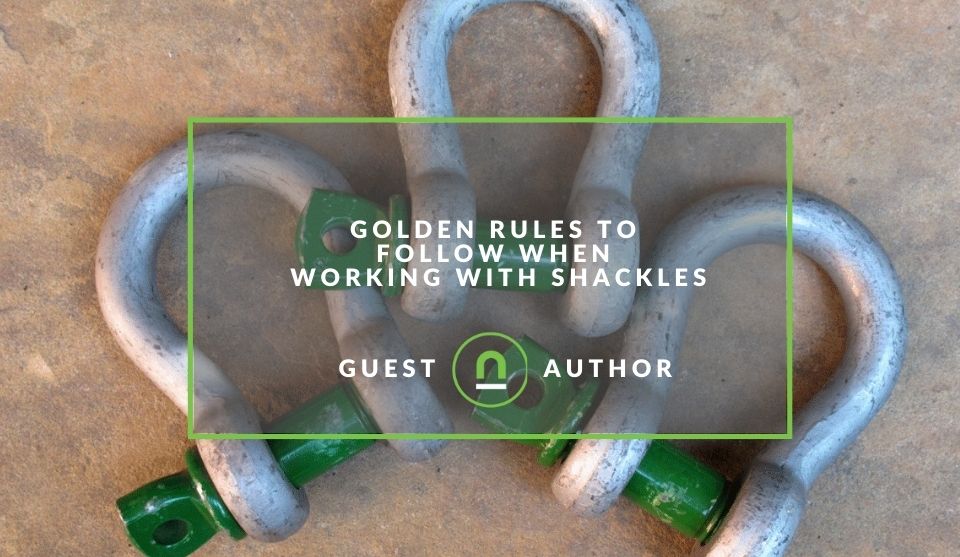Recent posts

nichemarket Advice
The South African VAT Threshold Chokehold
05 December 2025

Doctors Orders
The Difference Between SOAP Notes and DAP Notes
02 December 2025

Petrol heads
Why Load Bin Accessories Make Your Bakkie So Much Easier to Live With
26 November 2025

Alarming
What Is The Part Time Job WhatsApp Scam?
25 November 2025
Popular posts
Extravaganza
Trending Music Hashtags To Get Your Posts Noticed
24 August 2018
Geek Chic
How To Fix iPhone/iPad Only Charging In Certain Positions
05 July 2020
Extravaganza
Trending Wedding Hashtags To Get Your Posts Noticed
18 September 2018
Money Talks
How To Find Coupons & Vouchers Online In South Africa
28 March 2019
5 Rules To Follow When Working With Bow Shackles
03 July 2022 | 0 comments | Posted by Kathy D in Hit the Road
Shackles are a daily tool for specific jobs, such as warehouses and docks, which engage in load carrying and lifting activities. Such is used for everyday lifting, towing, and rigging to secure the loads. Gyve also provides a durable and robust connection between two joints to lift the load safely.
However, before using the bow and dee shackles, there are critical rules you need to observe as such rules ensure safety when using the shackles. As a result, this article will showcase the five crucial rules you can follow when using the shackles.
Shackle’s vulnerability to temperatures
Shackles are vulnerable due to high or low temperatures that could affect their quality. They are metallic. Hence, they are vulnerable because of thermal conditions such as extensive and minimum temperatures. When subjected to high temperatures, the shackles can expand unevenly and eventually break open or affect the integrity when carrying large loads. When subjected to lower temperatures, it can contract and ultimately rupture.
Therefore, when using the shackles, you must consider the thermal conditions. It would help if you did not use them to carry too hot loads since the heat can transmit easily through the metals and may eventually lead to an accident. On the contrary, you must also not use it in freezing temperatures.
However, you can use different shackles in extremely cold areas, such as synthetic shackles and ropes, instead of metal shackles. Moreover, you can contact a shackle supplier to get shackles suitable for particular weather conditions.
You must understand the minimum and maximum temperatures when working with shackles to avoid accidents. One can use the shackles for minimum temperatures of -4 degrees F and maximum temperatures of 400 degrees F. Anything below and above the given temperatures can trigger an accident, especially when lifting loads.
Locating the screw pin
The second rule when using the shackles is safety when anchoring the shackles before lifting the loads. The users should ensure the shackles are correctly engaged. To engage the shackle, you must screw the pin to have the threads fully involved in the shackle area. Remember, the screw pin should be on the outer shackle or past the shackle body. This enables you to observe the screw pin when operating the shackles.
This allows you to see when the pin is untightening, and you can tighten them to avoid an accident. The hook should be long enough to be exposed out of the shackle body. This gives enough room so that when the load is too high and the pin bends, the shackle does not rapture and has enough space for expansion. The users can observe the contraction and fix the challenge.
The next consideration is ensuring the pin head makes contact with the shackle body. This provides a tight grip so that there is no bigger gap left in the expansion case. The contact with the body also increases the load you can lift or pull without excess pressure on the shackle body. Finally, you must ensure the bolt nut and cotter shackles have the bolt and nut adequately secured with a cotter pin attached.
Using shackles for permanent and semi-permanent needs
The third rule is to ensure the shackles are applicable for permanent and semi-permanent usage. This rule states that if you plan to use the shackles for permanent and semi-permanent use, you must use the bolt nut cotter and anchor-style shackles. You should also apply the rule when you plan to suspend the load for a longer duration.
This rule is ideal for using shackles in areas such as warehouses to lift goods. It can also apply to sites involving intensive activities such as heavy lifting around the docks and malls. Once done with the lifting, return the screw pin shackles.
However, if you decide to use the screw pin when lifting the loads for longer, you should tie the pin or the shackle’s body with a wire—this help to boost its integrity when lifting large loads for longer durations. The wire provides additional safety when lifting large loads and ensures the load does not overwhelm the pin and cause a rupture. The wire ensures the pin does not rupture under the loads.
Using different types of shackles
The fourth rule is about how to use different types of shackles, specifically the D-shaped shackles, including extended reach and chain shackles. Every type of shackle is suitable for a specific use; for instance, the D-shaped shackles are ideal for use on in-line tension. They should only carry loads that are not in line.
They should not carry any side load since such loads can lead to expansion of the shackles, affecting their integrity. This makes the shackles ideal for towing and pulling in-line loads. The centre line of the shackle should be in line with the centre line of the load. You need to limit the side loads, and in case of any need to carry the loads, you must consider the regulations in the reductions in rating charts.
Using shackles and wire ropes
The ultimate rule is how to use the shackles using wire ropes. The shackles should equal or be larger than the diameter of the wire rope. This ensures the shackle diameter, maintains its integrity, and fits perfectly when connected to the wire ropes.
Conclusion
The rules will help you maintain safety when using the shackles since shackles are vulnerable to accidents triggered by factors such as different thermal conditions. It would be best if you considered these rules, whether using the shackles for lifting or pulling the loads.
Tell us your story
Would you like to write for nichemarket just like Kathy has? Find out how to submit a guest post and when you're ready, you can contact us.
Are you looking to promote your business?
South African logistics businesses and freelancers can create your free business listing on nichemarket. The more information you provide about your business, the easier it will be for your customers to find you online.
Registering with nichemarket is easy; all you will need to do is head over to our sign-up form and follow the instructions. If you require a more detailed guide on how to create your profile or your listing, then we highly recommend you check out the following articles.
Recommended reading
If you enjoyed this post and have time to spare, why not check out these related posts and dive deeper down the rabbit hole that is logistics.
- How Blockchain Can Improve The Transportation Industry
- Small Business Strategies for Cargo Tracking & Asset Management
Tags: Logistics, Guest Post
You might also like
The South African VAT Threshold Chokehold
05 December 2025
Posted by Che Kohler in nichemarket Advice
How South Africa's R1 Million Limit Keeps Small Businesses From Developing, And Why Even Adjusting For Inflation Alone Would Free Up Burdens On Small...
Read moreThe Difference Between SOAP Notes and DAP Notes
02 December 2025
Posted by Che Kohler in Doctors Orders
A look at SOAP format, which remains the classic choice for healthcare professionals, while DAP notes offer more flexibility for mental health docume...
Read more{{comment.sUserName}}
{{comment.iDayLastEdit}} day ago
{{comment.iDayLastEdit}} days ago
 {{blogcategory.sCategoryName}}
{{blogcategory.sCategoryName}}
